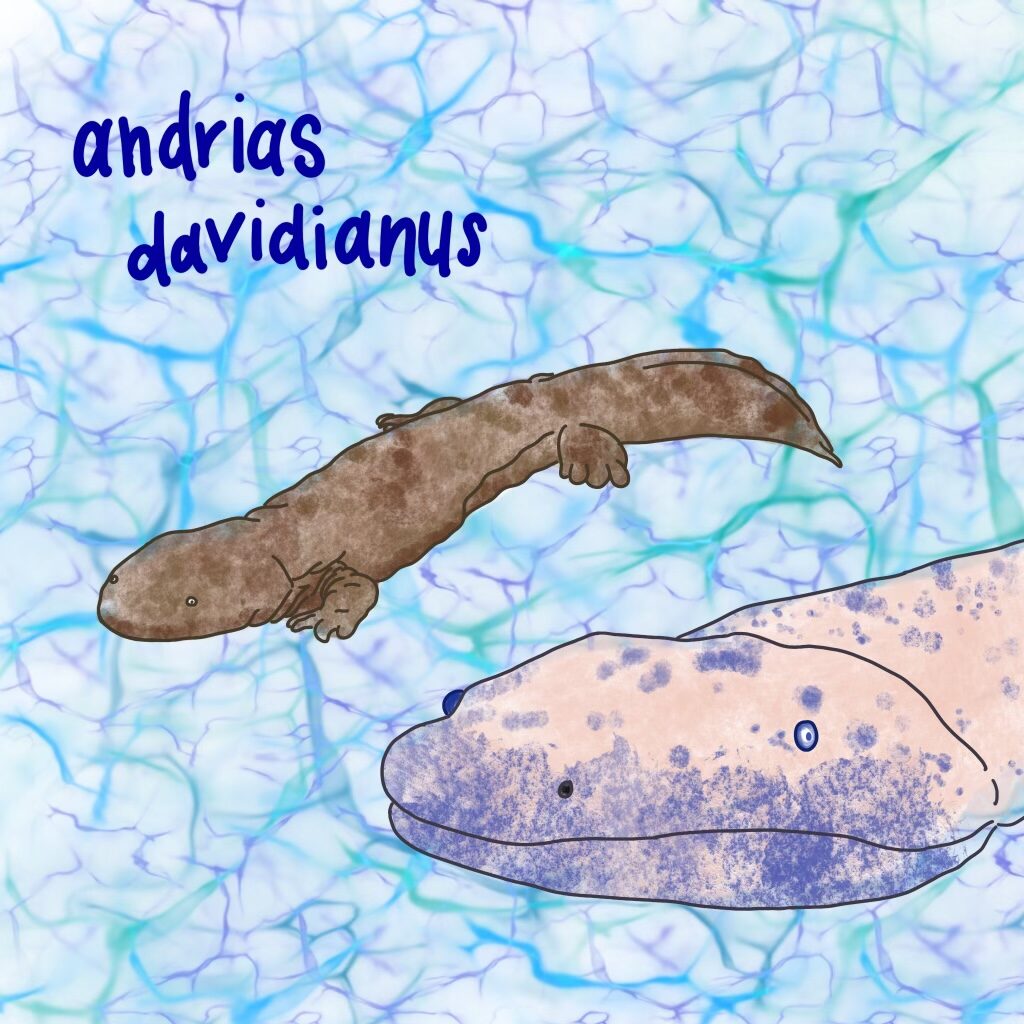“…and today we’re talking about an animal whose official name violated the order force rule of grammar and I hate that. But more on that later.”
The rivers in China are home to one of the largest salamanders—nay, one of the largest amphibians—in the world. Blending in with the rocks that line the riverbeds, the Chinese Giant Salamander spends its entire life beneath the rushing waters. This long-lived wriggle monster can breathe, see, and even heal itself using nothing but its unique skin. It just goes to show that skincare can sometimes be a matter of Life, Death, and Taxonomy.
Description of the Chinese Giant Salamander

- The salamander has a large head, small eyes, and wrinkled, dark skin.
- It has a broad, flat head with a wide mouth and round, lidless eyes, as well as a line of paired tubercles circling its head and throat.
- Colors include dark brown, reddish brown, black, or brownish tones with mottled or speckled patterns.
- There have been reports of albinos, which are white or orange in color.
Measure Up
Welcome to the beloved Measure Up segment. The official listener’s favorite part of the show! The part of the show when we present the animal’s size and dimension in relatable terms through a quiz that’s fun for the whole family. It’s also the part of the show that’s introduced by you when you send in audio of yourself saying, singing, or chittering the words Measure Up into ldtaxonomy at Gmail dot com. We do have a measure up intro from Melissa.
Length
- 1.15 m (3.8 ft)
- How many Chinese Giant Salamanders go into the length of the Long March, the longest recorded march in military history?
- Hint: The Long March was a military retreat of the First Red Army, the vanguard of the Chinese Communist Party in the 1930s. The march took a full year from October 1934 to October 1935 and started in Yudu in the province of Jiangxi to Yan’an in Shaanxi. The retreat was forced under pressure from the Nationalist forces of the Kuomintang.
- 7,781,052 salamanders. The march was 9,000 kilometers (5,600 mi).
Weight
- 25–30 kg (55–66 lb)
- How many salamanders go into the weight of a fully loaded Republic P-47 Thunderbolt, the heaviest single engine plane in World War II?
- Hint: The fighter was produced by the U.S. company Republic Aviation. It was capable of carrying 2,500 lb (1,100 kg) of payload.
- 242 salamanders. The Thunderbolt was 16,000 pounds or 8 tons, when fully loaded.
Fast Facts about the Chinese Giant Salamander
The CGS is a fully aquatic and nocturnal creature that lives in mountain streams in the Yangtze River Basin.
It’s critically endangered because of habitat loss and over-collection. It’s considered a delicacy and used in traditional Chinese medicine.
Insects, millipedes, horsehair worms, amphibians (both frogs and salamanders), freshwater crabs, shrimp, fish, and Asiatic water shrews.
They are also cannibals a lot.
They can’t see very well.
Giant salamanders don’t like the heat and will die in temps of 95 degrees or higher.
Females lay around 500 eggs, which are guarded by the male until the eggs hatch. They have several courtship displays, including a belly bump.
Young salamanders have gills until they reach three years old. They reach maturity at five years old. They can live for about 60 years. Undocumented claims (likely lies) say that salamanders have reached 200 years old.
Major Fact: Skin Deep
Despite being so big and normally the apex predator of its environment, the giant salamander needs some interesting adaptations to survive–particularly in its skin.
For starters, whenever they’re threatened or injured, they secrete a white slimy mucus that is rich in proteins. This can seal and heal wounds.
It functions as a medical adhesive and has been proven to work in pigs and rats.
It has a low risk of infection and reduces scarring.
Researchers have even made a bioadhesive out of the salamander’s skin goo called SSAD.
The plan is to use it for sutureless wound closure in the future. Possibly even on internal organ wounds.
The Chinese have been using salamander gunk to treat burns for over 1500 years.
So if you’re injured in China, and a giant salamander happens to be nearby, just slap on some of its skin slime, and you should be right as rain.
Also, the salamander’s skin is lined with special sensory nodes. Since its eyesight is pretty terrible, it depends on these nodes to sense vibrations in the water around it and detect prey by triangulating the vibrations.
Lastly, just like frogs can drink through their skin, giant salamanders have semi-permeable skin that allows oxygen to be absorbed from the water.
The salamander spends its entire life underwater, yet it doesn’t have gills–rather, it has lungs. So rather than needing to float up to the surface to grab a delicious gulp of air, it just sucks in the oxygen around it.
So the giant salamander just sits at the bottom of a river and uses its skin to breathe, see, and heal.
Ending: So keep your skin slimy, blend in with your background, and absorb what you need via osmosis, like the Chinese Giant Salamander here in LDT.

